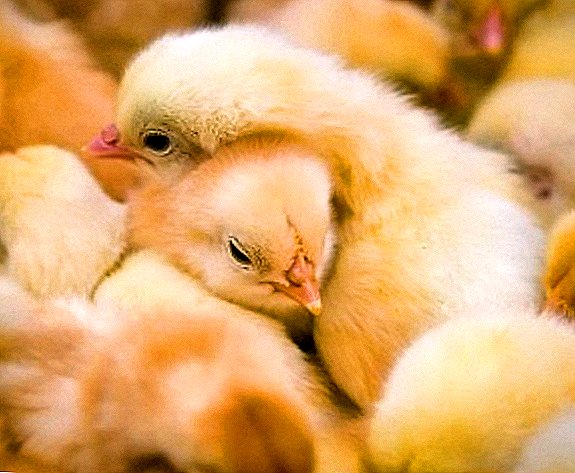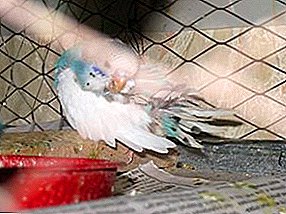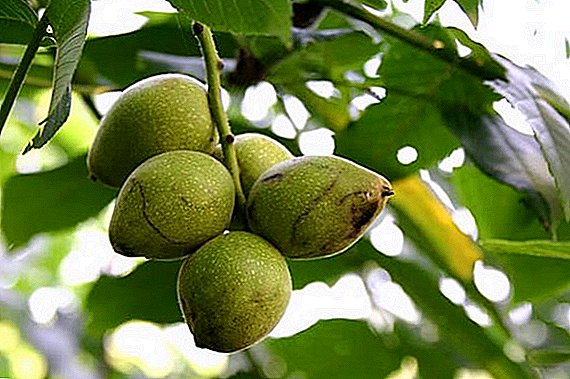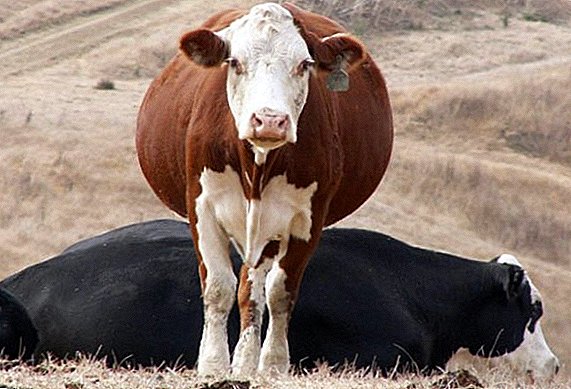 Farm animals are bred solely for profit. And high-quality, proven products delight not only the table of the owners, but also the wallet. It is precisely for this reason that the losses suffered as a result of exceptional incidents bring much hassle to farmers.
Farm animals are bred solely for profit. And high-quality, proven products delight not only the table of the owners, but also the wallet. It is precisely for this reason that the losses suffered as a result of exceptional incidents bring much hassle to farmers.
Especially disturbing miscarriages in cows. Why is this happening and how to avoid this trouble, we will tell.
What is a miscarriage
Abortion is the early termination of the process of pregnancy, which occurs as a result of various pathological conditions of the mother's body, unfavorable conditions of its maintenance or poor-quality diet.
Important! About 5-35% of pregnancy in cows end in miscarriage.Cases of pathological abortion are most often observed in autumn and winter, and this contributes to the growth of infectious diseases, poor diet, lack of walking and natural insolation.

Varieties
Often, arbitrary termination of pregnancy occurs at about 5-6 months. This leads to complications in the health of the animal and often to prolonged, costly treatment or even death. There are several types of miscarriages, which are distinguished by etiology and source, which led to this situation.
By type of source
According to the type of reason that led to the abortion, there are two main groups:
- Symptomatic. When the pregnancy is terminated due to the condition of the mother. For example, the cow's body could not tolerate the effects of various factors and a miscarriage occurred.
- Idiopathic. Depends on the condition of the fetus. For example, if something went wrong in the development of the embryo (congenital anomalies, deformities, etc.), then the mother's body rejects the fetus.
Did you know? Cows are the most productive farm animals. Every year they can produce 1000-8000 liters of milk, and their carcass contains 200-600 kg of meat.
According to etiology
First of all, miscarriages happen with full or partial loss of the fetus. Therefore, abortions are divided into:
- full - all embryos die;
- incomplete - at least one fruit can remain alive.
 According to the conditions of origin, abortion is divided into three types:
According to the conditions of origin, abortion is divided into three types:
- non-infectious;
- infectious;
- invasive.
Read about cow's pregnancy: how to determine how long it lasts and how to feed the animal during this period.
Further classification allows you to find out the causes of abortion and help make the right decision on the treatment of the animal. So, abortion is divided into:
- Non-infectious idiopathic. It happens as a result of anomalies or pathologies in the development of the embryo. These can be diseases of the kidneys, liver, heart, and other vital organs. Symptomatic is distinguished from this type. It arises as a result of the relationship of the mother and fetus. This type includes traumatic, climatic, alimentary and toxic.
- Infectious idiopathic. It happens in case of infection of a cow with various infections (leptospirosis, listeriosis, brucellosis, campylobacteriosis, salmonellosis). Symptomatic appearance is found in tuberculosis, foot and mouth disease, mycosis.
- Invasive idiopathic. Occurs with toxoplasmosis or trichomoniasis. Symptomatic appearance occurs as a result of blood parasitic diseases.

Find out what are the symptoms and methods of treatment of leptospirosis in cattle.
Causes of miscarriage of a cow
The main causes of symptomatic abortions are the following factors:
- Invasive diseases (brucellosis, trichomoniasis, etc.). In a sick animal, the infection spreads to the embryo and it stops developing. In this case, the fetus also becomes infectious, so after a miscarriage, the barn is treated with disinfectants, and the cow itself is culled.
- Various infectious or respiratory diseases. Different organs can be affected: the respiratory tract, the gastrointestinal tract, the circulatory system, etc.
- Complications at the previous calving (afterbirth delay, endometritis). In these pathologies, the integrity of the muscular layer of the uterus is disturbed, as a result of which the ligaments become weak and inelastic. This reason is the most common. Moreover, miscarriages occur at each subsequent insemination and at the same time - 5-6 months. These cows are no longer used for brood.
- Poor quality feed. Miscarriages mainly occur in the early stages.
- Overweight or underweight. This results in either a shortage of feed, or an excessive amount of concentrates and grain mixtures in the diet. In such cases, the animal’s immunity decreases and susceptibility to infection increases. At the same time, metabolism is disturbed, which leads to abortion.
- Deficiency in the diet of mineral elements (calcium, zinc, iron, phosphorus). In large farms for this reason, massive miscarriages can occur. In this case, the farmer must analyze the composition of the feed and improve it.
 When trichomoniasis in a cow, the fetus can also become infected and die
When trichomoniasis in a cow, the fetus can also become infected and die
Did you know? Even 30-40 g of chalk or bone meal will help prevent abortions and save future offspring.
- The lack of protein adversely affects the development of the embryo.
- Vitamin A deficiency. It leads to deterioration of epithelial tissue, in which the placenta and epidermis do not develop. Miscarriages occur mostly in the early stages. With a lack of retinol, a cow can bear the fruit, but after birth it may not survive for long. As a rule, such calves have poorly developed respiratory and digestive systems.
- Lack of tocopherol. Mainly provokes hidden abortions, in which the fetus is either resorbed or mummified. If you bring the diet of the animal back to normal, it will be able to make healthy offspring in the future.
- Vitamin E deficiency. With its lack of miscarriages occur over a period of 6-7 months. When a deficiency of this vitamin is detected, multivitamin therapy immediately begins.
- Injuries. Often, falling on the floor, hitting the “tribesmen” with the horn and other cases can cause an abortion.
- Drinking too cold water. When this occurs, reflex spasm of blood vessels, which leads to oxygen starvation and death of the fetus. The optimum water temperature for drinking water is up to +10 ° C.
- Genetic abnormalities in the fetus. It occurs in individuals and does not lead to distribution to other cows. As a result of abnormal disturbances, the embryo is unable to develop, and the cow discards it.
- Heat stress. It may also affect reproductive function. Is infrequent reason.
- The presence of toxic substances in the feed. It leads to abortion both in early and in later periods. The bottom line is that in plants or feed there are nitrates and nitrites, which adversely affect the course of pregnancy. Basically for this reason miscarriages occur in late periods.


How to determine that a cow has a miscarriage
Recognizing whether a pathological abortion has occurred is not difficult. In order to determine the infectious nature of abortion, you need to monitor the following signs:
- miscarriage occurs simultaneously in a large number of cows within the same farm or settlement;
- abortion occurs in all animals at the times described above;
- on examination of the fetus, the shirt covering it is covered with a yellowish bloom, resembling the appearance of millet porridge;
- after miscarriage occurs afterbirth delay.
 The interruption itself usually takes place easily, without any particular exertions, and an inattentive livestock breeder accidentally finds in the barn a thrown, usually dead, fetus. After an abortion in animals from the birth canal, a dirty mucopurulent fluid is released, which is infectious.
The interruption itself usually takes place easily, without any particular exertions, and an inattentive livestock breeder accidentally finds in the barn a thrown, usually dead, fetus. After an abortion in animals from the birth canal, a dirty mucopurulent fluid is released, which is infectious.
Important! If it is an infectious disease, then it can persist on the farm for many years and the treatment for the most part does not work. To prevent infection of animals vaccinated.Mostly in the first trimester of pregnancy signs of miscarriage are not noticed. Symptoms appear already at a later date. Key features:
- decreased appetite;
- lactation decline;
- changes in the quality characteristics of milk;
- in non-lactating animals, the udder swells;
- the animal has anxiety, attempts;
- disclosure of the cervical canal, there is a bloody-dirty fluid.
Fetal loss result
The consequences of abortion can be different. In some cases, the calf can be saved, and sometimes you have to save the cow itself. 
Exodus with full exile
Full rejection of the dead fetus is the most common type of miscarriage. Mostly occurs at 3-5 months of pregnancy. The embryo is expelled after 1-3 weeks, with no signs of decomposition.
About the death of the fetus say the following symptoms:
- the fetus does not move;
- the cow has colostrum;
- in milk females, milk yield decreases.
Find out what is the reason and how to treat infertility in a cow.
In such a situation, care should be taken to fully extract the fetus and to treat the likely complications.
Embryo death and complications
Such an outcome is fraught with adverse consequences for the mother's body.
The embryo killed in the womb (the so-called hidden abortion) decomposes, and the decay products are absorbed into the body. At the same time, the corpus luteum in the ovary continues to persist until the final lysis of the tissues of the embryo and its membranes.  As a result, a delay in the restoration of sexual cycles, which ultimately can also cause early termination of pregnancy. If the embryo died after 11-13 days, then the degree of excitation of the sexual cycle increases by 17-25 days.
As a result, a delay in the restoration of sexual cycles, which ultimately can also cause early termination of pregnancy. If the embryo died after 11-13 days, then the degree of excitation of the sexual cycle increases by 17-25 days.
Most often, a hidden abortion is set at a re-examination, after 2-3 months, and notice the signs of a previously established pregnancy.
Nursing probability
There are cases of rejection of the premature fetus (noob). The process is almost like childbirth: the whole complex or most of the harbingers of delivery are observed.
Important! If the stink is covered with wool, there is a chance of it coming out. But it should take into account the cause of miscarriage (infectious or non-infectious).The calf appeared quickly dried, transferred to a warm room with a temperature of + 25-30 ° C, covered with a blanket and wrapped in heaters. They feed only with colostrum and mother's milk heated to body temperature. If mother's milk can not be used, they are looking for a calf for the calf.
It is recommended to infuse calf mother's blood. If the stranger has no sucking reflex, it will not work.  In any case, the composition of milk (when replacing the milk of other animals) should be close to the parent.
In any case, the composition of milk (when replacing the milk of other animals) should be close to the parent.
Control and prevention measures
In order to eliminate preterm labor as much as possible, you should follow these rules:
- No later than 60 days before delivery, the cow is separated from the herd and run into dead wood. In large farms it is permissible to form groups of pregnant cows, but no more than 25 animals each.
- Before transferring the bed animal to another place, it is thoroughly washed and disinfected.
- Before artificial insemination, a cow is vaccinated against brucellosis and tuberculosis. This procedure is done a month before the intended insemination.
- The animal is kept tied to prevent injury.
- Strictly monitored nutrition. It must be balanced and contain a sufficient amount of vitamins and beneficial elements.
- Regularly, for 2-3 hours, walk the cows. 3-4 days before childbirth walks stop.
Important! To prevent miscarriages, you should eliminate all the factors that can cause them.If pregnancy occurred in the summer, then when walking a cow, you should watch her. Wet grass, a large number of succulent plants can lead to overeating. In this case, tympania, intestinal blockage and other problems in the gastrointestinal tract may develop. Such diseases lead to abortions.
Is it possible to have an abortion for cows
Artificial abortions are rarely used in veterinary practice. To do this, the animal must have the following indications:
- narrowing and curvature of the pelvic canal with the development of scab and tumors;
- abundant, cow-threatening uterine bleeding;
- dropsy of fetal membranes;
- "stale" on the eve of childbirth;
- exhaustion of the mother's body by multiple pregnancies;
- osteomalacia and other pathological processes that affect pregnancy or labor.
 To perform artificial abortions, there are several operational methods using mechanical or thermal stimulation of the uterus.
To perform artificial abortions, there are several operational methods using mechanical or thermal stimulation of the uterus.Did you know? On average, cows are pregnant for 285 days. In this case, the exact date of calving is impossible to determine, since pregnancy can vary within 240-311 days.Summing up, I would like to note that caring for cows during pregnancy, creating comfortable conditions for them and protecting them from infections will make it possible to get healthy offspring. Do not forget to regularly examine the animal for the presence of direct and indirect signs of abortion.












